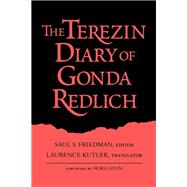The Terezin Diary of Gonda Redlich
, by Redlikh, Egon; Kutler, Laurence; Levin, Nora; Friedman, Saul S.; Friedman, Saul S.- ISBN: 9780813118048 | 0813118042
- Cover: Hardcover
- Copyright: 11/1/1992
In 1941, the fortress city of Terezin outside Prague was converted by Reinhard Heydrich into an ostensibly model ghetto. Stories circulated that it would be a transit station for Jews being sent where they might survive. In actuality it was a way station to Auschwitz. Of the more than 140,000 Jews of Moravia and Bohemia who went through Terezin, only some 17,000 were still alive in 1945. Out of 15,000 children, barely 100 survived.
Gonda Redlich was a young Zionist who grew up in Moravia and became interested in youth work. When he was deported to Terezin in December 1941, the ghetto elders selected him to be in charge of the youth welfare department. In that position, he was responsible for the housing, care, and education of all the children who eventually passed through Terezin.
Evidently aware of the historical significance of the events in which he was involved, Redlich kept a diary from the beginning of his stay at Terezin in which he chronicled the fear and desperation of life in the ghetto, the attempts people made to create a cultural and social life, the disease and death that were part of daily existence, the rumors and futile hopes. He also recorded the guilt and shame he felt at being forced, as a member of both the transport and the appeals committees, to select individuals to be transported to a fearful destination unknown to him.
Redlich himself, with his wife and child, was sent to Auschwitz in October 1944, but before his deportation he concealed the diary, which was not discovered until 1967, when Czech workers found it in the attic of a building in the ghetto. Here translated for the first time from Hebrew and Czech to English and richly annotated, the diary constitutes a significant document of Holocaust experience. It provides an emotional journey through hope and despair.
Gonda Redlich was a young Zionist who grew up in Moravia and became interested in youth work. When he was deported to Terezin in December 1941, the ghetto elders selected him to be in charge of the youth welfare department. In that position, he was responsible for the housing, care, and education of all the children who eventually passed through Terezin.
Evidently aware of the historical significance of the events in which he was involved, Redlich kept a diary from the beginning of his stay at Terezin in which he chronicled the fear and desperation of life in the ghetto, the attempts people made to create a cultural and social life, the disease and death that were part of daily existence, the rumors and futile hopes. He also recorded the guilt and shame he felt at being forced, as a member of both the transport and the appeals committees, to select individuals to be transported to a fearful destination unknown to him.
Redlich himself, with his wife and child, was sent to Auschwitz in October 1944, but before his deportation he concealed the diary, which was not discovered until 1967, when Czech workers found it in the attic of a building in the ghetto. Here translated for the first time from Hebrew and Czech to English and richly annotated, the diary constitutes a significant document of Holocaust experience. It provides an emotional journey through hope and despair.






